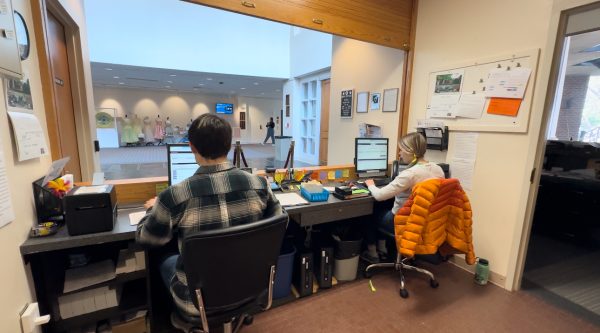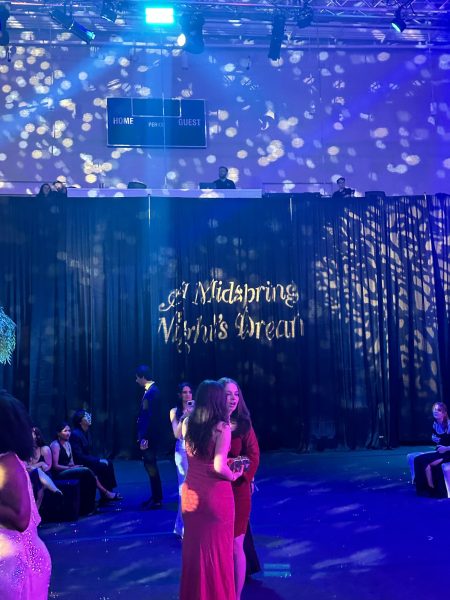Staniar hosts annual Senior Art Thesis Exhibition
Five seniors showcased their work in the multimedia gallery exhibit
April 13, 2021
On March 29, Staniar Gallery opened the annual senior thesis exhibition, displaying the culmination of six studio art majors’ year-long thesis projects.
Gabriela Gomez-Misserian, ‘21, one of the featured artists, turned her focus to bodies of water, specifically currents to create a multimedia gallery of studies and reflections on local water bodies in Current.
In the stress of the pandemic, Gomez-Misserian said she turned to Goshen pass to find peace and worked to capture its magic through oil paintings on mylar, pencil and ink drawings and hints of embroidery work.
“I find so much joy in creating my own ecosystem on the studio wall, creating an imaginative space wholly for myself, made by myself, from my own sketches torn out of my books, from moments in nature, drawing from life,” she said.
Mary Stephen Straske, ‘21 also found artistic inspiration and joy from the nature of Rockbridge County, which she captured through plexiglass printmaking techniques to create a large pattern-centric wall installation.
Straske says she drew nostalgic connections to the detailed garden wallpaper in her grandparent’s home as she developed her work, though her tendency towards patterns and motifs stems from her medium.
“I see each print as one smaller piece of a larger puzzle. There are endless variations that contribute to making a print: how hard I scratch the plexiglass, over or under inking a plate, or if I paint each organism from memory or a guidebook,” Straske said. “It is a messy and real process, and is one that allows me to translate these specific forms through my own filter of experience, thus constructing my world of chance.”
Liza Moore, ‘21, drew inspiration from natural organisms, specifically butterfly wings to create large-scale, abstracted, almost-psychedelic drawings and a large handmade latch-hook titled 384 hours for the time-consuming labor of its creation.
Moore says her work is repetitive, but necessary and ultimately soothing which is why she titled it Assembly Line Therapy.
“My work is not flexible once I begin assembling it. My work is compulsory and a form of therapy for me as the repetitive work allows me to zone out the stressors of 2020 and complete the goals I set out for myself,” Moore said.
Missy Barro, ‘21, said her compulsion is collecting, which started when she was young. She said she would pocket everything from cicada shells and leaves in the fall to arrowheads found on her family’s property.
For Barro’s thesis, she tried to reflect what she saw as nature bending to compensate for the presence of people and manmade structures or “this story of fragmentation, adaptation and resilience.” She used a wide variety of media including plastic packing peanuts, hair, yarn, pomegranates, avocados, cement, iron, natural dyes and thread.
“This is a story of bodies and forms in relationship to one another, and this series is defined by the juxtaposition between the softness of the yarns and the hardness of the metal,” she said.
Like Barro, Reggie Zhao, ‘21 took a strongly multimedia approach to her thesis, exploring ideas of space, particularly in urban settings like the crowded one she grew up in, with materials readily available or from previous projects.
Her use of bamboo and the crisp sound of its tissue inspired Zhao to explore the aural as a medium that enhances the visual.
Through interactive 3D works, Zhao invites gallery-goers to pay attention to sounds of materials we take for granted in “The Ontology of Daily Materials.”
“This collection of work reflects my journey on a sustained investigation of the ontology of materials– their genesis, potentials, afterlives, et cetera,” Zhao said.
Emma Coleman’s, ‘21 work “From Fontella” takes a deep dive into her family history and ancestry in Coleman Falls, Virginia.
Coleman describes Fontella Road as the trunk of her family tree from which all the other branches grow.
“The family creeps from Coleman Falls to Big Island, from Big Island to Buena Vista, from Buena Vista to Lexington, from Lexington to White Sulphur. And it leaves traces as it goes. Old addresses. Workplaces. Letters. Gravestones,” Coleman said.
Coleman’s printed diptychs, collages and photographs act as her way of connecting the dots and grappling with her ancestral past in an effort to acknowledge “my poor, mountain, hillbilly roots” in spite of stereotypes or stigma.
“And I am still tracing,” she said. “Still tracing old documents. Still scanning old photos. Still comparing faces and scars. Still visiting the places where my ancestors stood and the graves where they lie, to document them as I know them, and to know my ancestors through them.”
You can view a recorded artists’ talk and virtual tour of the gallery through the Staniar Gallery website.












